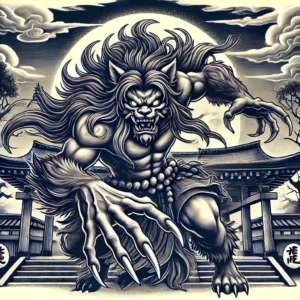Japanese folklore is rich with a variety of supernatural entities known as yokai. Among these fascinating beings is the Yasha, a creature rooted in ancient mythology and Buddhist traditions. In Japanese culture, Yasha are often depicted as fierce and powerful demons, embodying both protective and malevolent qualities.
Origin and Mythology
The Yasha, derived from the Sanskrit word “Yaksha,” has its origins in Hindu and Buddhist mythology. Initially, Yakshas were nature spirits associated with wealth and fertility, but as the concept traveled to Japan, it evolved. In Japanese folklore, Yasha transformed into demonic beings with a more fearsome reputation. These entities are often depicted as warrior-like figures, showcasing their strength and ferocity.
Appearance and Characteristics
Yasha are typically portrayed with a fearsome appearance, featuring sharp claws, fangs, and a muscular build. They are often shown with wild hair, fierce expressions, and sometimes with multiple arms or eyes. This terrifying visage emphasizes their power and demonic nature.
Despite their fearsome looks, Yasha are complex creatures. They can be both protectors and harbingers of destruction, depending on the context in which they appear. This duality makes them unique among yokai, as they can serve as guardians or adversaries.
Role in Folklore
In Japanese folklore, Yasha often appear as protectors of sacred places, such as temples and shrines. Their fierce nature makes them ideal guardians against evil spirits and other malevolent forces. However, they can also be vengeful and destructive, punishing those who desecrate sacred spaces or disrupt the natural order.
Yasha are also featured in various Japanese tales and literature, often serving as formidable foes for heroes to overcome. Their presence in these stories underscores their role as both protectors and challengers, adding depth to their mythological significance.
Yasha in Popular Culture
The influence of Yasha extends beyond traditional folklore into modern popular culture. They appear in various forms of media, including manga, anime, and video games. These contemporary portrayals often retain their demonic characteristics while adapting their stories to fit new narratives and settings.
For example, in the popular manga and anime series “Inuyasha,” the character Inuyasha is a half-demon with traits reminiscent of traditional Yasha. His fierce appearance and warrior spirit highlight the enduring appeal of these mythological beings.

The Yasha is a captivating yokai with a rich history rooted in ancient mythology. Their dual nature as both protectors and destroyers makes them a fascinating subject in Japanese folklore. Through their appearances in traditional tales and modern media, Yasha continue to captivate and intrigue audiences, showcasing the enduring power of these mythical creatures.
